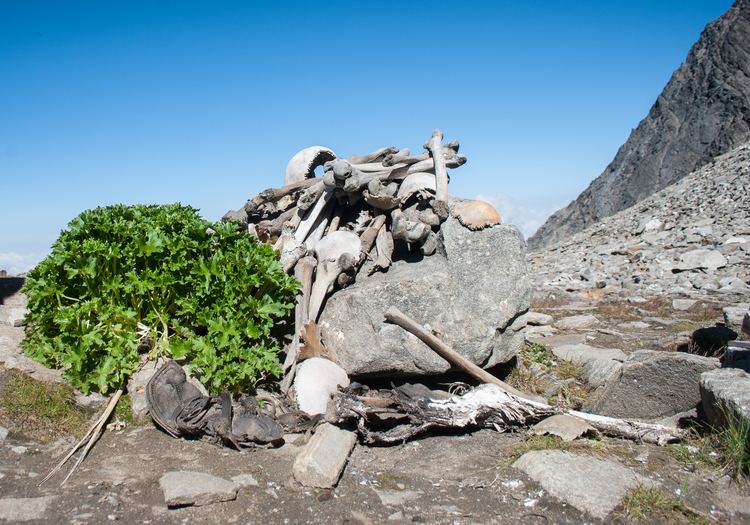District Chamoli Time zone IST (UTC+5:30) Elevation 5,029 m | Founded by None Vehicle registration UK | |
 | ||
Similar Nanda Devi, Valley of Flowers National, Lohajung, Chadar trek, Hemkund | ||
Uttarakhand roopkund lake don t miss
Roopkund (locally known as Mystery and Skeletons Lake) is a high altitude glacial lake in the Uttarakhand state of India. It lies in the lap of Trishul massif and is famous for the hundreds of human skeletons found at the edge of the lake. The area is uninhabited, in the Himalayas at an altitude of 5,029 metres (16,499 feet). Surrounded by rock-strewn glaciers and snow-clad mountains, the lake is a popular trekking destination.
Contents
- Uttarakhand roopkund lake don t miss
- Map of Roop Kund Uttarakhand 246435
- Roopkund skeleton lake a himalayan mystery
- Human skeletons
- Identification
- Conservation concerns
- Tourism
- Roopkund skeletons in popular culture
- References
Map of Roop Kund, Uttarakhand 246435
A shallow lake, having a depth of about two metres, Roopkund has attracted attention because of the human skeletal remains that are visible at its bottom when the snow melts. Researchers have concluded that the skeletons are the remains of people killed in a sudden, violent hailstorm in the 9th century. Because of the human remains, the lake has been called Skeleton Lake in recent times.
Roopkund skeleton lake a himalayan mystery
Human skeletons
Skeletons were rediscovered in 1942 by a Nanda Devi game reserve ranger H K Madhwal, although there are reports about these bones from the late-19th century. At first, British authorities feared that the skeletons represented casualties of a hidden Japanese invasion force, but it was found that the skeletons were far too old to be Japanese soldiers. The skeletons are visible in the clear water of the shallow lake during a one-month period when the ice melts. Along with the skeletons, wooden artifacts, iron spearheads, leather slippers, and rings were also found. When a team from National Geographic magazine retrieved about 30 skeletons, flesh was still attached to some of them. Geneticists, Niraj Rai along with Manvendra Singh at the Center for Cellular and Molecular Biology at Hyderabad, conducted DNA tests on a hundred samples from the lake and compared them to the current Indian population. Results indicated that 70 percent of them had an affinity with Iran, while the remaining belonged to the local population. It is hypothesized that the Iran group took the help of local porters to seek new land for settlement. Later studies placed the time of mass death around the 9th century CE (1,200 years old).
Local legend says that the King of Kanauj, Raja Jasdhaval, with his pregnant wife, Rani Balampa, their servants, a dance troupe and others went on a pilgrimage to Nanda Devi shrine, and the group faced a storm with large hailstones, from which the entire party perished near Roopkund Lake.
Remnants belonging to more than 300 people have been found. Radiocarbon dating of the bones at Oxford University's Radiocarbon Accelerator Unit determined the time period to be 850 CE ±30 years. The Anthropological Survey of India conducted a study of the skeletons during the 1950s and some samples are displayed at the Anthropological Survey of India Museum, Dehradun.
Identification
Scientific tests from a 2004 expedition to the lake revealed that the skeletons belonged to several groups of people, including a group of short people (probably local porters) and a taller group, who were closely related—with DNA mutations characteristic for Konkanastha Brahmins (Chitpavans) from Maharashtra. A DNA test conducted by the Centre for Cellular and Molecular Biology (CCMB), Hyderabad, indicated that three samples with unique mutation in mitochondrial DNA, matched with those of the Chitpavans.
The studies of the skeletons revealed a common cause of death: blows to the back of the head, caused by round objects falling from above. The researchers concluded that the victims had been caught in a sudden hailstorm, just as described in the local legends and songs.
What has not been determined is where the group was headed. There is no historical evidence of any trade routes to Tibet in the area, but Roopkund is on an important pilgrimage route of the Nanda Devi cult with Nanda Devi Raj Jat festivities taking place approximately once every twelve years.
Conservation concerns
There is a growing concern about the regular loss of skeletons and it is feared that, if steps are not taken to conserve them, the skeletons may gradually vanish in the years to come. It is reported that tourists visiting the area are in the habit of taking back the skeletons in large numbers and the district administration has expressed the need to protect the area. The district magistrate of Chamoli District has reported that tourists, trekkers, and curious researchers are transporting the skeletons on mules and recommended that the area should be protected. Governmental agencies have made efforts to develop the area as an eco-tourism destination in an effort to protect the skeletons.
Tourism
Roopkund is a picturesque tourist destination and one of the important places for trekking in Chamoli District, Himalayas, near the base of two Himalayan peaks: Trisul (7,120 m) and Nanda Ghunti (6,310 m). A religious festival is held at the alpine meadow of Bedni Bugyal every autumn with nearby villages participating. A larger celebration, the Nanda Devi Raj Jat, takes place once every twelve years at Roopkund, during which Goddess Nanda is worshipped.: Roopkund lake is covered with ice for most of the year.
Roopkund skeletons in popular culture
Roopkund's skeletons were featured in a National Geographic documentary, "Riddles Of The Dead: Skeleton Lake".
